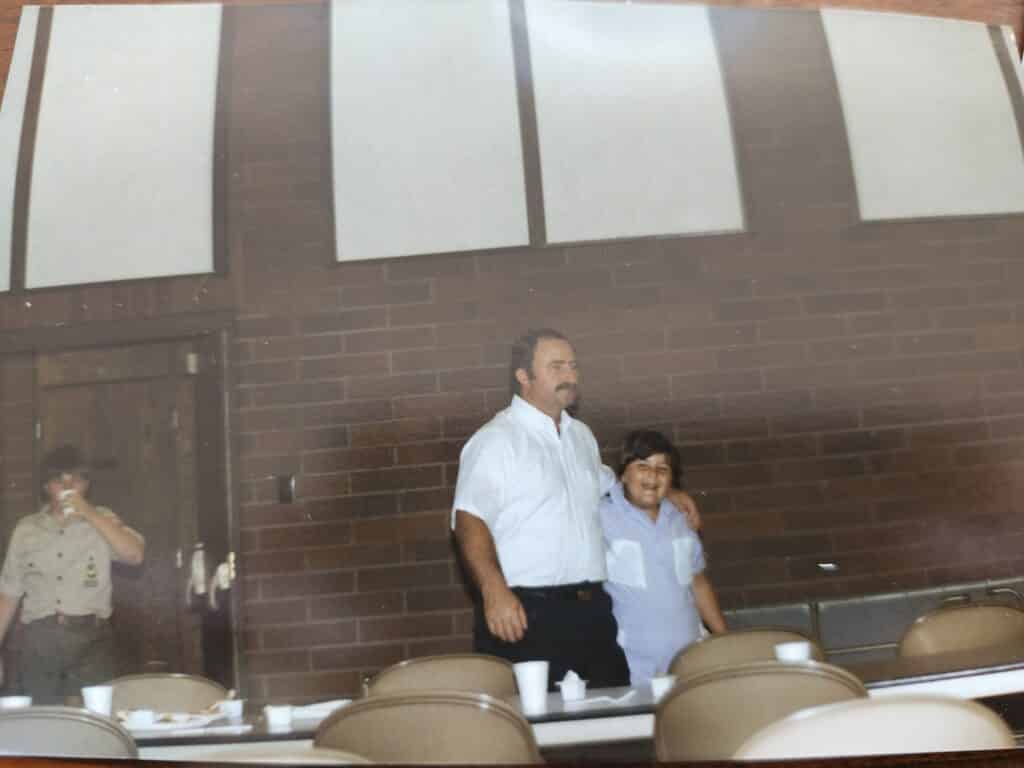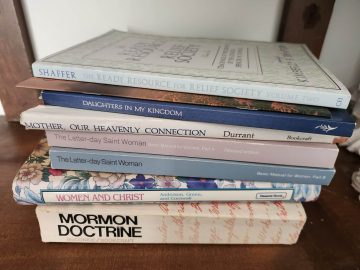The history of specific expectations related to how women dress and care of their bodies is as lengthy as religion; however I’d argue the LDS experience is unique. Our bodies have a multitude of expectations and are a frequent topic of conversation and counsel. Recent changes to the garment led me to relive a lot of the moments in which I felt overwhelmed by the expectations. My first memory of these expectations was as a young child.

My parents were often needed at the church building throughout the week. My dad was a scoutmaster, the kind that’s so dedicated they have a campout once a month and there’s always something to attend. When I scrunch my face to remember, the words “arrow of light, eagle’s nest, court of honor, posting the colors” come to mind. As a young girl I was bored out of my mind and would wander through the building and sometimes even run in the halls with other kids. One evening I decided to take a shortcut through the chapel which resulted in an adult scolding me because I had been in the chapel while wearing pants. I was told I always had to be in a dress if I was going to be in the chapel, yes even to go through the dark unlit overflow to get to the other side. My eyes went wide as the adult explained that the sacrament table is where the symbolic body of Christ is laid and blessed. I could not be in its presence without wearing a dress. I silently wondered why Heavenly Father would be mad at me for wearing pants in there when the boys were wearing play clothes too. For the most part I heeded the lesson I was taught that evening. When I broke the rule and went through the darkly lit or empty chapel, I’d feel bad and repent. Even as a grown-up.
Sometime in the 90’s I watched as a sister a few years older than I walked reverently to the pulpit and addressed the congregation. She’d been called to serve a mission for the Lord, a sacrifice she was excited and proud to make. Few obligations remained before she could travel to the missionary training center in Provo, Utah. One of those was an obligation she’d decided to complete with her fellow ward members as witness. She carefully and quietly raised her fingers to her nose and removed her tiny studded piercing. It felt like a really big moment. Collectively the ward exhaled like she had just made a lifesaving, good choice. The energy of that Sunday was ecstatic and everyone smiled and relived the moment as we waited for our classes to begin. How could the removal of such a small adornment create such a huge moment for us all?
I think it was such a big moment because ear piercings alone could lead to being questioned about your level of commitment to the Lord. Girls are counseled to not get piercings unless for medical reasons. If you really desire to have your ears pierced only one “modest” pair would be considered appropriate. When President Hinckley specifically addressed having more than one pair of earrings the message reverberated through rows in young women’s and relief society classes. Keeping more than one modest pair was disobedient and years later Elder Bednar would proclaim “Those who choose to disregard this counsel sow a lack of respect for themselves and for God. They will someday regret their decisions.”
There were many instances in my life when I felt like I had stopped breathing to absorb a new-to-me or changed expectation from church leadership. Fast forward to decades after that first memory to the time I’d talked about the temple with my dad. He was concerned about me and when I came to visit we took my kids to the beach and talked. My toes wiggled nervously in the sand and I struggled to meet his gaze when he asked me how I was feeling about “the church” and if I believed anymore. I asked him the question that had been weighing on my mind ever since receiving my endowment. “Dad, why do I have to hide my face from Heavenly Father if he loves me? What father would want that?” Veiling my face had always made me feel uncomfortable and less worthy than the men filling the rows in on the other side of the room during the endowment. The last session I had attended had been particularly difficult for me and I wasn’t planning on returning to the temple again. “Shhhhh,” my dad said and shook his head. “There are some things we don’t talk about outside of the temple.” I looked down at the sand, unable to keep looking into his eyes. I mumbled something about not knowing what I believed anymore and the conversation changed as we sat on the beach watching my children play in the waves.
When the news spread that women would no longer have to veil their faces during significant parts of the endowment ceremony it hit me like a sneaker wave. Previously, not veiling your face could hold up the entire session and being slow to do it meant receiving stares. Was this change an “Oops actually Heavenly Father doesn’t care if you show your face or not and we just thought he did?” And if that’s the case why wasn’t that changed when so many other things in the endowment ceremony changed over the last century? I didn’t feel a sense of victory or relief when that expectation changed. I felt hurt that my pain was for nothing and not worth acknowledging. There’s no do-over and I ache for those who hold memories like mine, of veiling their beloved grandmothers or other loved sisters before closing their casket lid. I mourn every woman buried with her face hidden, whose identity of divine worth felt diminished by this practice.
Outside of Mormonism, if a man told a large group of people including many women to not ““wander around looking like men, put on a little lipstick now and then and look a little charming” I dare to think the collective reaction would be shock, maybe even people walking out. When Elder Ballard said this from the pulpit, a collective laugh resounded throughout the chapel. Why was the reaction one of laughter? Years or decades of coercive expectations created that sound of laughter. Laughter that no doubt hid embarrassment, shame, self-loathing, and more.
For the health of our bodies, of our minds, and of our spirits, I hope that the brethren will someday understand that women can create expectations for themselves and trust that they understand their relationship with the Lord and His will. Stop counting earrings or telling women to wear lipstick. Women are of divine worth, don’t gatekeep it with inconsistent expectations.






6 Responses
I remember as a teenager being told by a member that I needed to wear a dress in the chapel. This was during one of the young women activities. I think me and some other young women had cut through the chapel to get to the other side of the building. I didn’t like that this member was telling us what to do, trying to enforce her own views on us. I wished she would mind her own business. She also told the youth they needed to shower before going to the temple. This was during a youth overnight trip of some sort, and I just did not want to shower because I was in a new place and didn’t feel comfortable. I was very shy back then and it made me feel so uncomfortable to have an adult telling me to do things a certain way. She wasn’t even a youth leader, from what I recall. She was there because she had teenagers at the activity. I know there are some members who are stricter than others, but that’s no reason to try and enforce their own ways on the youth.
Because Mormonism insists that everything is a revelation from God, we tend to insist that there is Great Meaning in everything we do, even when we have no reason to believe that, and no instruction about what things are supposed to mean. Essentially everything in the temple falls into this category. Every word, every symbol, every piece of clothing down to the last detail (number of leaves on the apron) are supposed to mean something, and many a church member goes repeatedly hoping to figure it all out. And then suddenly, things change without explanation. And members feel lost, because things that were supposed to be meaningful turn out to be ephemeral. Once this happens a certain number of times, we start to question whether any of it has any meaning. Wearing temple robes one way, and then another surely must be important, right? Why else would we go through the effort of putting them all on, and then taking them off and rearranging them ten minutes later? And then suddenly, putting them on twice isn’t needed at all. One time will do. Why was it the old way? Why is it the new way? No one knows. But if two isn’t the right answer, why should I believe that 1 is?
The root cause of all of this is The Church’s insistence that they are right about all things at all times. There is no humility, only hubris. Church leadership insists that they understand things 100%, while other people (who only “play church” according to some) understand 0%. In truth, the brethren might understand 30%, while “the world” is at 28%. (I’m being generous to the Q15, and plenty of that 28% is stuff that is outside “our” 30%.)
A great many Mormons that I know understand the gaps in their own knowledge. They understand that they are bumbling along in life, making mistakes all over the place, but still doing their best to move forward and they do many wonderful things along the way. This is amazing. They are a testament to humanity, because they sure didn’t learn these traits from The Church.
I’ve been wearing pants to church for years now. For a while I used a knee scooter and I just never went back to a skirt. I upgraded my pants so that they were nicer slacks. I’m still wearing the same tops I used to wear with a skirt. From the waist up nothing has changed. I’ve had a few comments (“Are you ever going to wear a dress again?” Answer: maybe). I own a couple of dresses but it’s nuisance to put on panty hose (a whole separate discussion). And I wonder why a denim skirt and flip flops are considered more appropriate than what I wear.
I remember that message about having multiple piercings. I ended up going and having more piercings. I didn’t get why it was disrespectful. I still don’t. I so get it on the temple experience. I also was taught you didn’t discuss anything outside of the temple as it was sacred. I seriously feel this is the reason why I had a major panic attack my first time and not even being taken to the temple president helped. I just remember how embarrassed my mother-in-law was. I didn’t care. I was angry no one had better prepared me. Flash forward two decades when I had another panic attack. This is when the ushers placed chairs blocking members from leaving. I was in the middle of two sisters and due to my anxiety with worrying I wouldn’t get the words/changing temple pieces right, I had a severe attack. Once again this temple president brushed off my anxiety and laughed. I’ve had numerous members, including my bishop, laugh or tell me I was lying as no one has an anxiety attack in the temple. And this whole ‘you feel peace’ in the temple? I never experienced that.
And on wearing modest clothing? More than a few times I’ve been told my clothing isn’t modest enough. Once I even had a missionary tell his mission president that the slit up my dress caused him to have ‘bad’ thoughts. That one also angered me. As if I put thoughts in his mind. As a survivor of s*xual abuse, that one-that it was my fault for how I dressed-continues to stay with me. I tell other young women not to let any man or even woman tell them otherwise.
My mother told me that the church would move away from shaming women. I hope this happens.
“I felt hurt that my pain was for nothing and not worth acknowledging.” This. It’s so hard.
Hear, hear! In my day it was also those damn pointy bras.